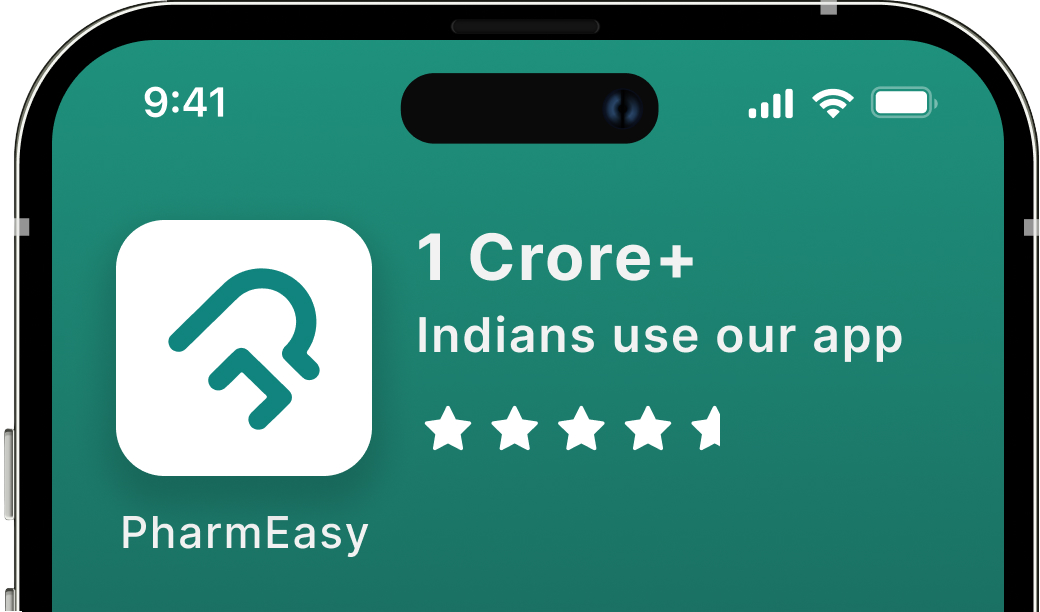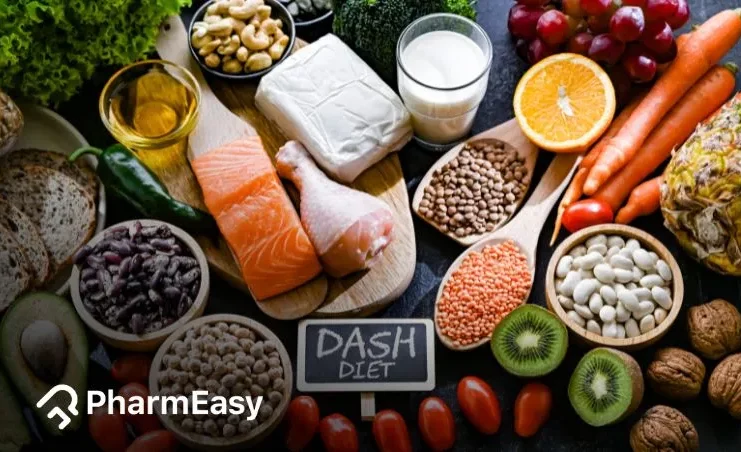How Does DASH Diet Helps To Reduce High Blood Pressure
By Dr. Ameya Tirodkar +2 more

Get,

to manage your symptom
Get your,


4 Cr+ families
benefitted

OTP sent to 9988776655



You’ve successfully subscribed to receive
doctor-approved tips on
Whatsapp

Get ready to feel your best.

Hi There,
Download the PharmEasy App now!!


Register to Avail the Offer
Send OTPBy continuing, you agree with our Privacy Policy and Terms and Conditions

Hi There,
Sign up on PharmEasy now!!
Trusted by 4 crore+ families

OTP sent to 9988776655



You have unlocked 25% off on medicines




Code: NU25
By Dr. Ameya Tirodkar +2 more
Table of Contents
High blood pressure or hypertension is a condition affecting more than a billion people worldwide. Often known as the “silent killer”, it can significantly strain the life of the affected person if not controlled well. One out of every third individual is affected by hypertension globally and this is estimated to increase by 20% by the year 2025.1
High blood pressure is a risk factor for various health conditions like heart diseases, kidney disease, and stroke (can lead to paralysis and disability). It is usually managed by medications, but research suggests that lifestyle changes with a particular focus on diet, can play a crucial role in supplementing the effect of prescribed medicines and exercise.1 Certain dietary patterns such as the DASH diet can potentially help regulate the blood pressure.2 In this blog, we will understand what is a DASH diet, its potential benefits and risks and how it helps manage hypertension. So, let’s get started.

DASH diet full form is “Dietary Approaches to Stop Hypertension” and it was originally designed by the National Institute of Health (NIH) as a measure for managing hypertension.
The DASH diet for hypertension limits the intake of saturated fat found in full-fat milk, cheese and butter, red meat (beef, pork, and lamb), sweets and sugars, and sodium (limit-1500 mg/dl), while it includes the consumption of protein, vegetables and fruits, dietary fibers, and minerals such as potassium, calcium, and magnesium.2
The serving guide for a patient following the DASH diet for hypertension is as follows:
A wholesome DASH diet plan includes vegetables, fruits, healthy carbohydrates, dairy, meat, and nuts, which are generally low in sodium and help maintain healthy blood pressure levels. Although, the DASH diet benefits extend beyond this.
The DASH diet also helps in maintaining healthy cholesterol (lowering LDL- bad cholesterol) and triglyceride levels, potentially reducing the risk of heart disease. Additionally, the DASH diet is found to be beneficial in improving insulin resistance and balancing blood sugar levels. Thus, this diet is considered to be a useful adjunct to medical therapy for individuals having metabolic syndrome. Moreover, its balanced nutrition plan can help promote weight loss and enable you to lead a healthy lifestyle.2,3
The DASH diet can potentially reduce systolic and diastolic blood pressure. It helps lower blood pressure and is particularly beneficial for younger individuals and those with a high intake of sodium and unhealthy eating habits.
The diet acts by helping clear off excess sodium from the body by increasing the intake of potassium and other minerals. The clearance of sodium and interaction with the hormone system of the body results in relaxation of blood vessels. When the blood vessels relax, they widen, making it easier for the blood to flow. Blood pressure is reduced because there is less force against the blood vessels. So, incorporating this diet into your lifestyle, more so along with physical activity and weight management, can help reduce your blood pressure effectively.5
The DASH diet benefits with effective implementation, and there are several determinants to it. Following the practical approaches mentioned below can help you with successful implementation and adherence to your diet plan.
The first step in the process is to consult a dietitian/doctor to assess if the DASH diet is a good fit for you. They will check your caloric requirement, weight goals, and cooking habits. After that, you will be handed over a meal plan and a shopping list to help you stay on track with your diet goals.2
So, once you have your diet plan in hand, it is important that you incorporate it gradually in your lifestyle. Start by making small changes like limits processed foods and then move on to the bigger ones. Sudden change can feel overwhelming and may lead to difficulty in maintaining the diet for a longer-term.2
Selecting the right types of food and eating mindfully are fore and foremost in attaining the maximum benefits of this diet. It is important to keep your shopping list handy. It ensures that you have the right foods in your hands for making healthier choices. Plus, following simple tips like planning meals in advance, choosing fresh and nutrient rich foods and cooking them at home can all help with effective implementation.2
Try to gain as much information as possible about the diet and its benefits. A short talk with your doctor can help you successfully make lifestyle modifications. Joining group sessions led by a dietician can help you stay motivated to follow the diet. You can take part in dietary workshops and seminars to achieve long-duration results, along with regular visits to your dietician.2
In today’s world, a mobile phone is an integral part of everyday life, making it the best way to implement the diet in real life. There are some reliable apps available that can be used to keep track of the diet plan. Once you enter your general information and basic needs, the app will create a diet plan based on DASH guidelines.2,7
Research studies suggest that strictly following the DASH diet leads to better results than following it flexibly.6 Early adoption, gradual changes, and support from family and peers can help you plan and follow the diet effectively, yet strict adherence and long-term sustainability is highly dependent on self-motivation.
So ultimately, these approaches can help you in implementing the diet plan, however adhering to and achieving your goals with this diet lies a lot in your own hands- your determination and consistency!
Although the DASH diet for hypertension is safe and effective, some side effects may occur in certain situations.
Although you may be concerned about nutritional deficiencies, this diet is usually so wholesome that it doesn’t really cause any deficiencies, and if you take the necessary precautions, you can avoid any side effects of following the DASH diet. Yet, it is always advisable to discuss with your doctor before starting any new diet. They can guide you best based on your medical condition.
The DASH diet is recommended if you have high blood pressure. If you are considering including DASH diet in your routine, you should visit your doctor:
Despite making changes to your diet and lifestyle, if your blood pressure levels are above 130/80mmHg, you must consult your doctor for medical advice.13
In a nutshell, the importance of DASH diet in managing high blood pressure cannot be overlooked. This approach to diet includes the consumption of high-fiber food content, healthy carbohydrates, and proteins, but with restrictions on the intake of saturated fat, simple sugars and sodium. It helps in removing excess sodium from the body, leading to relaxation of blood vessels and lowering of blood pressure. Yet, a smooth implementation requires proper dietitian consultation, information gathering and making use of technology along with self-motivation and support. Although the DASH diet is safe and effective, some precautions are necessary in certain situations, so it’s advised to always discuss with your doctor before beginning. Overall, incorporating the DASH diet into your routine and following it effectively may help achieve successful results in managing blood pressure levels along with other potential health benefits.
Yes, the diet includes beans and whole grains, which are rich sources of protein along with fruits and vegetables which can be followed by vegetarians.14
Eggs can be included in the DASH diet as a source of animal protein.2
When you combine exercise and DASH diet it improves blood vessel function and nervous system control. This combination can enhance its effects.2
Coffee intake can temporarily increase blood pressure which can interfere with the goal of the DASH diet to reduce it. Therefore, it may be best to avoid coffee.15
Alcoholic beverages can increase blood pressure in both men and women. Avoiding alcohol is the best way to maximize the benefits of a DASH diet.16
Disclaimer: The information provided here is for educational/awareness purposes only and is not intended to be a substitute for medical treatment by a healthcare professional and should not be relied upon to diagnose or treat any medical condition. The reader should consult a registered medical practitioner to determine the appropriateness of the information and before consuming any medication. PharmEasy does not provide any guarantee or warranty (express or implied) regarding the accuracy, adequacy, completeness, legality, reliability or usefulness of the information; and disclaims any liability arising thereof.

Leave your comment...
Comments